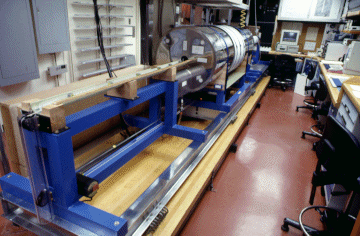

Laboratory Methods
Paleomagnetism
Lab Documentation
- Cookbook (PDF)
- Standard operating procedure (PDF)
- Instrument inventory (PDF)
Shipboard paleomagnetists provide the first paleomagnetic analysis of sediments and rocks recovered by ODP. This information is used by shipboard and shore-based scientists as the basis for further sampling the study, and for forming the first general conclusions about the geologic history of the drilling site. The shipboard paleomagnetists have a tremendous responsibility to the scientific community to provide accurate and reliable data. Hence, the paleomagnetics laboratory on board the JOIDES Resolution contains state-of -the-art equipment to perform detailed paleomagnetic and rock-magnetic measurements.
Shipboard Procedures
Most shipboard scientists find that the transit to the first site is the best
time to become familiar with the ship and routines. Prior to arriving at the
first site, the paleomagnetists and the paleomagnetics Marine Specialist should
review procedures for each piece of equipment in the lab, check calibrations,
and discuss how shipboard paleomagnetic data are processed and plotted.
Ideally this should be completed before drilling the first site, amended later
in the leg to reflect actual practice, and given in final form to the Staff
Scientists before the end of the cruise. A general correlation scheme between
biostratigraphic zones, the record of magnetic polarity reversals, seafloor
magnetic anomalies, and an absolute time scale should be agreed upon by
paleomagnetists and biostratigraphers.
Typically, two paleomagnetists sail on each cruise and work opposite 12-hour
shifts. The paleomagnetics Marine Specialist is at present not dedicated full
time to the paleomagnetics lab, so that he/she also has responsibilities on
the core-receiving deck and in the core lab. The shipboard paleomagnetists
conduct or supervise all paleomagnetic measurements and the reduction of
paleomagnetic data to intensities and direction of magnetization. Data must be
compiled in a manner comfortable with ODP standards and format, as explained
by the paleomagnetics Marine Specialist at the beginning of the leg.
Paleomagnetic Samples
In addition to measuring the archive halves of the core, shipboard paleomagnetists normally deal with two categories of discrete samples during the cruise: shipboard samples and personnel samples, which are taken according to individual scientists' approved sample requests and are subject to ODP sampling limits and guidelines.
Core Orientation
Oriented cores provide potentially the best paleomagnetic information. The Eastman-Whipstock multishot tool and the Tensor tool can orient cores to within a few degrees, enabling paleomagnetists to determine the magnetostratigraphy of sediment even from equatorial regions and to study both geomagnetic-field behavior and plate motions.
Partial Demagnetization of Archive Sections
The pass-Through cryogenic magnetometer provides the high-resolution records required in studies of magnetostratigraphy and magnetic-field behavior. An alternating-field (AF) demagnetizer in-line with the cryogenic magnetometer can demagnetize cores up to 80 mT, which, in many cases, is sufficient to remove secondary magnetization. In September 1992 the Information Handling Panel (IHP) recommended that shipboard paleomagnetists be allowed to partially demagnetize the archive half-section of any core to as high a level as is necessary to isolate the characteristic remanence. The maximum demagnetization step size is limited to 15 mT to prevent the destruction of core magnetization without a record of intermediate data. Shipboard paleomagnetists are encouraged to take discrete shipboard samples that can then be demagnetized either thermally or at alternating fields up to 100 mT. These results can then be compared to the results of demagnetization of archive halves to determine whether or not secondary magnetizations were adequately removed.
Cryogenic Magnetometer
The 2G 750-R superconducting rock (cryogenic) magnetometer is used primarily for continuous remanence measurements on archive halves of cores. AF coils arranged on-axis with the magnetometer and set within the magnetometerÍs mu-metal shielding allow uniform demagnetization of the cores, so that both NRM and demagnetized remanences can be measured. The cryogenic magnetometer may also be used to measure and demagnetize discrete samples.
Spinner Magnetometer
The Molspin Minispin spinner magnetometer is a basic field unit interfaced with a microcomputer for control and data acquisition. The software driving the Minispin executes spin sequences and calculates declination, inclination, and intensity in mA/m corrected for the volume of the sample. A series of measurement is made on each sample as it is run through a demagnetization sequence. Ordinarily, six separate spin orientations are required to produce an accurate measurement. In general, the processing rate will vary with the NRM intensity and response to demagnetization of the samples from a particular lithologic unit.
Demagnetizers
A Schonstedt Alternating Field Demagnetizer, Model GSD-1, is available for
demagnetization of discrete samples of rock or sediment. The user can select
a range of peak alternating fields from 0 to 100 mT. A new DTECH D-2000 AF
demagnetizer will be installed during Leg 172. It is capable of reaching peak
fields of 200 mT and can be used for ARM and pARM studies.
A Schonstedt Thermal Demagnetizer, Model TSD-1, is used for thermal
demagnetization of dry rock samples over a temperature range of 0° to 800°C. The instrument contains magnetically shielded heating and cooling chambers.
Rock Magnetic Equipment
An ASC Impulse Magnetizer, Model IM-10, is available for studies of the acquisition of isothermal remanence (IRM) and anistropy of IRM. The DTECH Partial Anhysteretic Remanent Magnetizer (PARM) can produce a direct current (DC) magnetic field upto 1 mT (10 gauss). The Kappabridge KLY - 2 Magnetic Susceptibility System measures magnetic susceptibility and anisotropy of magnetic susceptibility at sensitivities of 0.05 to 200,000 x 10-6 SI. (Because the JOIDES Resolution is a magnetically noisy environment, the sensitivity is less than in shielded rooms in shore-based labs but is sufficient for most shipboard purposes.) Other Equipment includes the Schonstedt Portable Three-Axis Fluxgate Magnetometer and the Barrington Magnetic Susceptibility Meter.

Resources